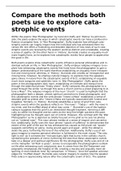Compare the methods both
poets use to explore cata-
strophic events
Within the poems ‘War Photographer’ by Carol Ann Duffy and ‘History’ bu John burn-
side, the poets explore the ways in which catastrophic events can have a profound in-
fluence on peoples lives. In ‘War Photographer’, Duffy explores how although cata-
strophic events can hugely impact how the individual who has witnessed them tra-
verses life, she offers a frustrating and desolate depiction of how news of such cata-
strophic events are received by the western world as distinct and unrelatable, creating
a sense of apathy. On the other hand, in ‘History’, Burnside creates an arguably much
more hopeful tone, as he explores how catastrophic events force people to apperceive
the good in life.
Both poems explore show catastrophic events influence personal philosophies and in-
dividual outlook on life; in ‘War Photographer’, Duffy employs religious imagery to ex-
plore how witnessing catastrophic events first hand force the photographer to gain a
deeper understanding of the world therefore establishing an arguably more introspec-
tive and moving tone, whereas, in ‘History’, Burnside also creates an introspective and
moving tone, however, he employs natural imagery, to explores how the speakers
gains solace in nature from the catastrophic events of 9/11, establishing an arguable
much more sanguine and optimistic tone. In ‘War Photographer’, Duffy opens the
poem in the photographers dark room, establishing an intimate and tranquil tone
through the adjectival phrase “finally alone”. Duffy compares this photographer to a
priest through the simile “as though this were a church and he a priest preparing to in-
tone a Mass”. The religious imagery of the noun “church” is used to highlight that the
photographer feels a deeper, almost spiritual connection to these photographs, and
this catastrophic events and the verb phrase “intone a Mass” establishes a sense of
desolate grief as priests who “intone a Mass are typically associated with funeral and
tragedies. Similarly, in ‘History’, Burnside establishes a sense of grief from cata-
strophic events when the speakers reflects on “the news”: “Today / - with the news in
my mind, and the muffled dread of what may come -“. Burnside’s use of the hyphen
caesura suggests that this grief is an interjected thought fragment, mirroring a diffi-
culty to collect his thoughts and be calms as the long line length quickens the pace,
highlighting how his thought seem out of control. However, this contrast with the ‘War
Photographer’ as he is depicted as totally focused on his grief as he sets his photos
out on “ordered rows”. This noun phrase insides at a sense of respect and concentra-
tion. Additionally, Duffy uses the noun phrase “spools of suffering” to demonstrate the
extent of the grief of the war he has witnessed has caused as the plural not “spools”
suggests something on going - being wound again and again - while the sibilance
slows the pace, furthering the tone of the reflection. Additionally, Duffy’s use of reli-
gious imagery to express personal refection is furthered in the main clause “The only
light is red” as it connotes the “red sanctuary light that burns in the catholic church,
symbolising the presents of christ, furthering the idea that these catastrophic events
take on a deeper and spiritual significance for the photographer. Duffy uses end of cut
on the metaphor “all flesh is grass”, serves to encapsulate the photographers outlook
on life after witnessing such cataclysmic war; it comes from the Old Testament and
poignantly emphasises the fragility of life, creating a moving and arguably more de-
spairing or even fatalistic tone. By comparison, in ‘History’, once the speaker acknowl-
edges his “muffled dread”, Burnside uses natural imagery to explore how the speaker
finds solace in appreciating nature after the catastrophic event of 9/11. The speaker




